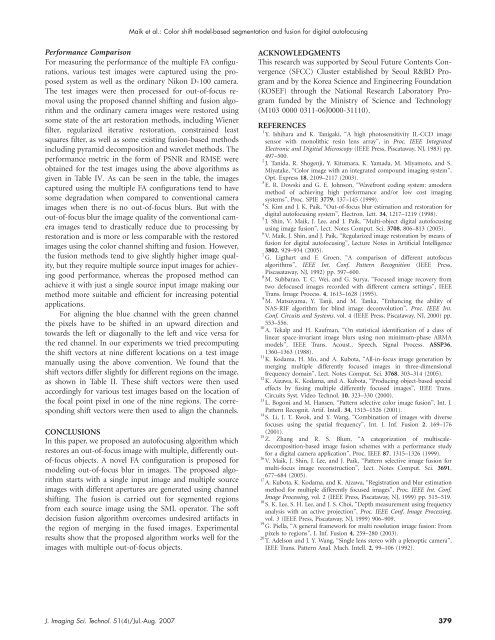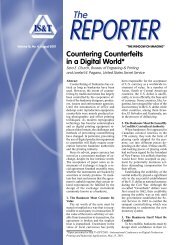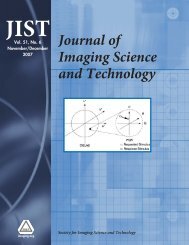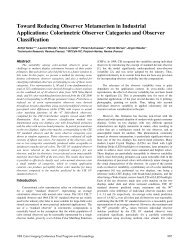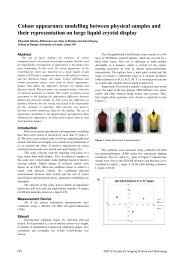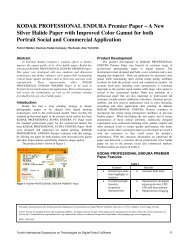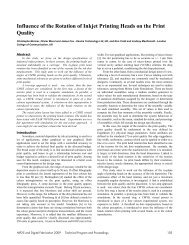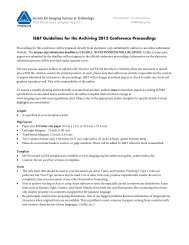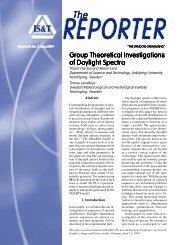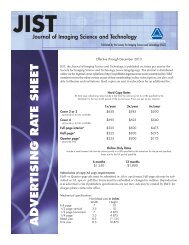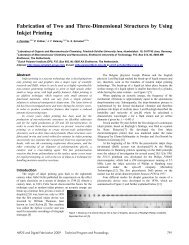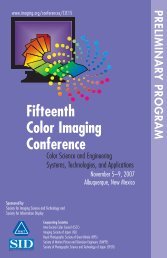Additional Material, Journal of Imaging Science - Society for Imaging ...
Additional Material, Journal of Imaging Science - Society for Imaging ...
Additional Material, Journal of Imaging Science - Society for Imaging ...
Create successful ePaper yourself
Turn your PDF publications into a flip-book with our unique Google optimized e-Paper software.
Maik et al.: Color shift model-based segmentation and fusion <strong>for</strong> digital aut<strong>of</strong>ocusing<br />
Per<strong>for</strong>mance Comparison<br />
For measuring the per<strong>for</strong>mance <strong>of</strong> the multiple FA configurations,<br />
various test images were captured using the proposed<br />
system as well as the ordinary Nikon D-100 camera.<br />
The test images were then processed <strong>for</strong> out-<strong>of</strong>-focus removal<br />
using the proposed channel shifting and fusion algorithm<br />
and the ordinary camera images were restored using<br />
some state <strong>of</strong> the art restoration methods, including Wiener<br />
filter, regularized iterative restoration, constrained least<br />
squares filter, as well as some existing fusion-based methods<br />
including pyramid decomposition and wavelet methods. The<br />
per<strong>for</strong>mance metric in the <strong>for</strong>m <strong>of</strong> PSNR and RMSE were<br />
obtained <strong>for</strong> the test images using the above algorithms as<br />
given in Table IV. As can be seen in the table, the images<br />
captured using the multiple FA configurations tend to have<br />
some degradation when compared to conventional camera<br />
images when there is no out-<strong>of</strong>-focus blurs. But with the<br />
out-<strong>of</strong>-focus blur the image quality <strong>of</strong> the conventional camera<br />
images tend to drastically reduce due to processing by<br />
restoration and is more or less comparable with the restored<br />
images using the color channel shifting and fusion. However,<br />
the fusion methods tend to give slightly higher image quality,<br />
but they require multiple source input images <strong>for</strong> achieving<br />
good per<strong>for</strong>mance, whereas the proposed method can<br />
achieve it with just a single source input image making our<br />
method more suitable and efficient <strong>for</strong> increasing potential<br />
applications.<br />
For aligning the blue channel with the green channel<br />
the pixels have to be shifted in an upward direction and<br />
towards the left or diagonally to the left and vice versa <strong>for</strong><br />
the red channel. In our experiments we tried precomputing<br />
the shift vectors at nine different locations on a test image<br />
manually using the above convention. We found that the<br />
shift vectors differ slightly <strong>for</strong> different regions on the image,<br />
as shown in Table II. These shift vectors were then used<br />
accordingly <strong>for</strong> various test images based on the location <strong>of</strong><br />
the focal point pixel in one <strong>of</strong> the nine regions. The corresponding<br />
shift vectors were then used to align the channels.<br />
CONCLUSIONS<br />
In this paper, we proposed an aut<strong>of</strong>ocusing algorithm which<br />
restores an out-<strong>of</strong>-focus image with multiple, differently out<strong>of</strong>-focus<br />
objects. A novel FA configuration is proposed <strong>for</strong><br />
modeling out-<strong>of</strong>-focus blur in images. The proposed algorithm<br />
starts with a single input image and multiple source<br />
images with different apertures are generated using channel<br />
shifting. The fusion is carried out <strong>for</strong> segmented regions<br />
from each source image using the SML operator. The s<strong>of</strong>t<br />
decision fusion algorithm overcomes undesired artifacts in<br />
the region <strong>of</strong> merging in the fused images. Experimental<br />
results show that the proposed algorithm works well <strong>for</strong> the<br />
images with multiple out-<strong>of</strong>-focus objects.<br />
ACKNOWLEDGMENTS<br />
This research was supported by Seoul Future Contents Convergence<br />
(SFCC) Cluster established by Seoul R&BD Program<br />
and by the Korea <strong>Science</strong> and Engineering Foundation<br />
(KOSEF) through the National Research Laboratory Program<br />
funded by the Ministry <strong>of</strong> <strong>Science</strong> and Technology<br />
(M103 0000 0311-06J0000-31110).<br />
REFERENCES<br />
1 Y. Ishihara and K. Tanigaki, “A high photosensitivity IL-CCD image<br />
sensor with monolithic resin lens array”, in Proc. IEEE Integrated<br />
Electronic and Digitial Microscopy (IEEE Press, Piscataway, NJ, 1983) pp.<br />
497–500.<br />
2 J. Tanida, R. Shogenji, Y. Kitumara, K. Yamada, M. Miyamoto, and S.<br />
Miyatake, “Color image with an integrated compound imaging system”,<br />
Opt. Express 18, 2109–2117 (2003).<br />
3 E. R. Dowski and G. E. Johnson, “Wavefront coding system: amodern<br />
method <strong>of</strong> achieving high per<strong>for</strong>mance and/or low cost imaging<br />
systems”, Proc. SPIE 3779, 137–145 (1999).<br />
4 S. Kim and J. K. Paik, “Out-<strong>of</strong>-focus blur estimation and restoration <strong>for</strong><br />
digital aut<strong>of</strong>ocusing system”, Electron. Lett. 34, 1217–1219 (1998).<br />
5 J. Shin, V. Maik, J. Lee, and J. Paik, “Multi-object digital aut<strong>of</strong>ocusing<br />
using image fusion”, Lect. Notes Comput. Sci. 3708, 806–813 (2005).<br />
6 V. Maik, J. Shin, and J. Paik, “Regularized image restoration by means <strong>of</strong><br />
fusion <strong>for</strong> digital aut<strong>of</strong>ocusing”, Lecture Notes in Artificial Intelligence<br />
3802, 929–934 (2005).<br />
7 G. Ligthart and F. Groen, “A comparison <strong>of</strong> different aut<strong>of</strong>ocus<br />
algorithms”, IEEE Int. Conf. Pattern Recognition (IEEE Press,<br />
Piscasataway, NJ, 1992) pp. 597–600.<br />
8 M. Subbarao, T. C. Wei, and G. Surya, “Focused image recovery from<br />
two defocused images recorded with different camera settings”, IEEE<br />
Trans. Image Process. 4, 1613–1628 (1995).<br />
9 M. Matsuyama, Y. Tanji, and M. Tanka, “Enhancing the ability <strong>of</strong><br />
NAS-RIF algorithm <strong>for</strong> blind image deconvolution”, Proc. IEEE Int.<br />
Conf. Circuits and Systems, vol. 4 (IEEE Press, Piscataway, NJ, 2000) pp.<br />
553–556.<br />
10 A. Tekalp and H. Kaufman, “On statistical identification <strong>of</strong> a class <strong>of</strong><br />
linear space-invariant image blurs using non minimum-phase ARMA<br />
models”, IEEE Trans. Acoust., Speech, Signal Process. ASSP36,<br />
1360–1363 (1988).<br />
11 K. Kodama, H. Mo, and A. Kubota, “All-in-focus image generation by<br />
merging multiple differently focused images in three-dimensional<br />
frequency domain”, Lect. Notes Comput. Sci. 3768, 303–314 (2005).<br />
12 K. Aizawa, K. Kodama, and A. Kubota, “Producing object-based special<br />
effects by fusing multiple differently focused images”, IEEE Trans.<br />
Circuits Syst. Video Technol. 10, 323–330 (2000).<br />
13 L. Bogoni and M. Hansen, “Pattern selective color image fusion”, Int. J.<br />
Pattern Recognit. Artif. Intell. 34, 1515–1526 (2001).<br />
14 S. Li, J. T. Kwok, and Y. Wang, “Combination <strong>of</strong> images with diverse<br />
focuses using the spatial frequency”, Int. J. Inf. Fusion 2, 169–176<br />
(2001).<br />
15 Z. Zhang and R. S. Blum, “A categorization <strong>of</strong> multiscaledecomposition-based<br />
image fusion schemes with a per<strong>for</strong>mance study<br />
<strong>for</strong> a digital camera application”, Proc. IEEE 87, 1315–1326 (1999).<br />
16 V. Maik, J. Shin, J. Lee, and J. Paik, “Pattern selective image fusion <strong>for</strong><br />
multi-focus image reconstruction”, Lect. Notes Comput. Sci. 3691,<br />
677–684 (2005).<br />
17 A. Kubota, K. Kodama, and K. Aizawa, “Registration and blur estimation<br />
method <strong>for</strong> multiple differently focused images”, Proc. IEEE Int. Conf.<br />
Image Processing, vol. 2 (IEEE Press, Piscataway, NJ, 1999) pp. 515–519.<br />
18 S. K. Lee, S. H. Lee, and J. S. Choi, “Depth measurement using frequency<br />
analysis with an active projection”, Proc. IEEE Conf. Image Processing,<br />
vol. 3 (IEEE Press, Piscataway, NJ, 1999) 906–909.<br />
19 G. Piella, “A general framework <strong>for</strong> multi resolution image fusion: From<br />
pixels to regions”, J. Inf. Fusion 4, 259–280 (2003).<br />
20 T. Adelson and J. Y. Wang, “Single lens stereo with a plenoptic camera”,<br />
IEEE Trans. Pattern Anal. Mach. Intell. 2, 99–106 (1992).<br />
J. <strong>Imaging</strong> Sci. Technol. 514/Jul.-Aug. 2007 379


